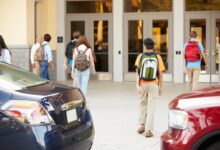
The focus and responsibility of everyone in the NSW Education system is being harnessed to transform student outcomes through the School Success Model. (SSM).
That was the commitment from Education Secretary Mark Scott and Education Minister Sarah Mitchell during their keynote speeches yesterday at the Sydney Morning Herald Schools Summit.
The two education leaders emphasised a renewed focus on evidence and data would underpin the approach with students at the centre of all decision-making.
Ms Mitchell said in her address the School Success Model would set a range of targets, in consultation with school leaders, for each school in areas as diverse as HSC, phonics, wellbeing, equity, attendance, pathways and NAPLAN.
“Under the SSM, schools that are meeting or exceeding their targets will be held up as examples of excellence,” she said.
“Schools that do not meet their targets will receive targeted support from the department so that they can be turned around.
“We must set lofty ambitions – and we must, as a system, question ourselves when we fail to live up to our ambitions.”
In his speech, Mr Scott said improvements to the education system required a holistic view that recognised “where local decisions and actions are needed, but also where the system needs to take the strain”.
“It cannot be about 2,200 individual schools all seeking to improve in isolation. Strength should come from the system,” he said.
Ms Mitchell said the department would be brutal in following best practice.
“We must without fear reject approaches that have been shown not to work – even if we have committed years of our lives to such approaches,” Ms Mitchell said.
“The whole of language vs. phonics debate is a perfect example of this.
“Neglecting to teach synthetic phonics in the early years is the educational equivalent of refusing to vaccinate our children.”
Mr Scott stressed the accountability and responsibility for success rested with everyone within the system.
He pointed to the recruitment of teaching professionals and reduction in administrative burden as ways in which the system could support frontline teachers.
“The most scarce and valuable resource in a school is time,” Mr Scott said.
“Since 2018 the department has delivered more than 50 time-saving initiatives, from significantly reducing the paperwork required for cash management in schools, to automating 60 per cent of the annual school report process and piloting and scaling the use of online enrolment by parents.”
Ms Mitchell also promised to address what she identified as the “biggest equity issue” in the sector – geography.
The rural-based politician pointed out that by Year 9, the gap between rural public school students and those in metropolitan areas was more than 14 per cent in reading and numeracy, and 20 per cent in writing.
“Everyone wants to talk about the problem with NSW’s results, but not the solution,” she said.
“The solution is more investment in the regions.
“Evidence shows that if we improved outcomes in our regional schools, NSW would lead the country and international rankings would lift.”
Ms Mitchell said a number of reforms now under way, including the Regional and Remote Education Strategy and Fast Stream Program, were about delivering quality education and the best teachers to the bush.







